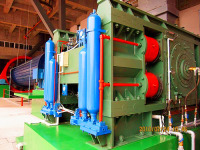|
LGM/LGSM Vertical Mill

Collect
商品说明
Since the 1990 s began to make vertical mill. Since 2001, according to the market needs and the needs of the development of enterprise products, set up special research and development of large vertical mill group, on the basis of the study abroad a variety of models combined with China's national conditions to determine the vertical grinding machine, the independent development of innovative research and development design with independent intellectual property rights of LGM series slag raw material vertical mill, roller mill and cement and vertical mill as the host of slag grinding process system. LGMS series vertical mill slag cement and cement raw materials LGM series vertical mill is a comprehensive large-scale grinding equipment, set of crushing, grinding, classifying, drying, material handling five functions into one, with a focus on process, small footprint, less investment, energy saving features. Vertical Mills Vertical Roller Mill Key benefits
How Vertical Roller Mill worksThe ZTIC mill combines the drying, grinding and separation processes into just one unit, which simplifies the plant layout. And because it operates at a low noise level, outdoor installation is feasible – substantially reducing civil construction costs and improving the working environment. Vertical Roller Mill Design advantages
An ounce of preventionEven though the mill is very sturdy, you should still be sure to:
Normal maintenanceWe recommend visually inspecting the mill every two weeks, both while running and stopped. Major maintenanceMajor jobs include reversal/change of segments and/or hardfacing. A full hardfacing usually takes 3-4 days. For clinker grinding, hardfacing is usually required annually; for slag grinding, expect to hardface every 3-4 months.The mill’s swing-in/out roller support system makes it easy to maintain the rollers and suspension system. Swinging one roller out and changing the seals takes 24 hours, while changing a hydraulic cylinder takes 10-16 hours. The mills have 2 access doors for ease of maintenance, and entry is possible as soon as the mill is stopped. Any jobs done inside the mill have to wait until it is cooled down – typically 3-4 hours. Watch the Mill Maintenance animation:Rollers and wear linersThe rollers and the wear liners of the grinding table are segmented and therefore easy to replace when worn out. Roller wear segments can easily be reversed or replaced while inside the mill – that is, without taking rollers out of the mill. The separator reject cone is provided with rail and trolley for that purpose.By reversing the wear segments of the rollers to use both sides of the segments, you can achieve higher utilisation. In case of instabilityInstability in the grinding process may occur in the case of:1. Excessive material in the mill 2. Lack of material in the mill 3. Extremely dusty feed 4. Worn segments Solve it by: 1. Adjusting mill feed 2. Increasing mill gas flow 3. Adjusting dam ring height and 4. Ultimately, re-welding or replacing segments |



















